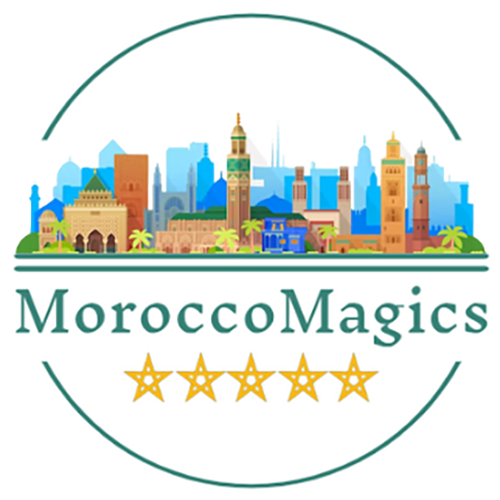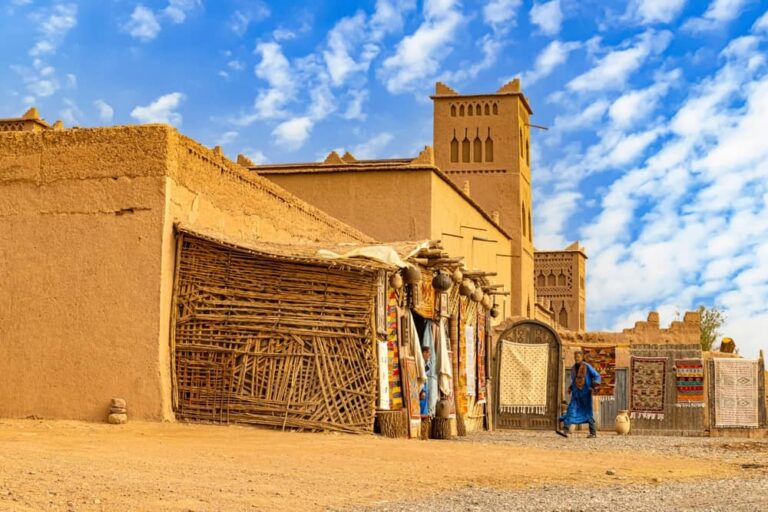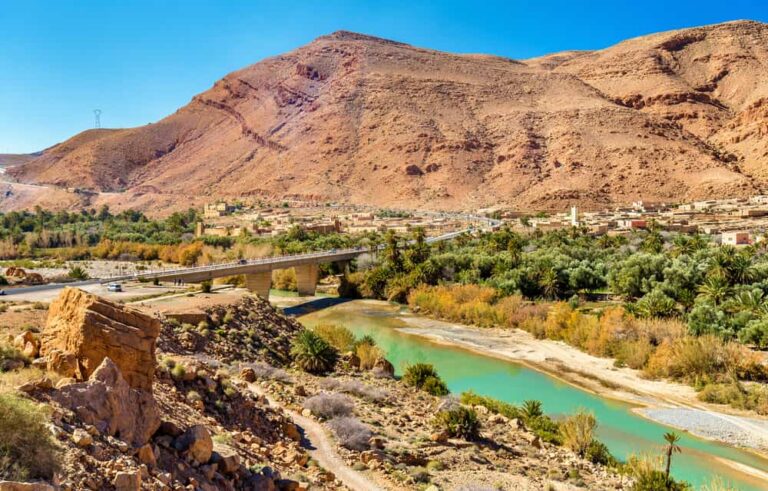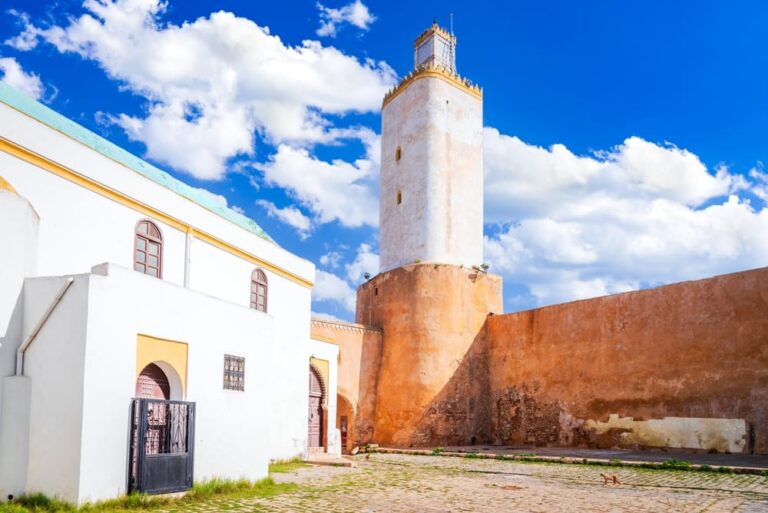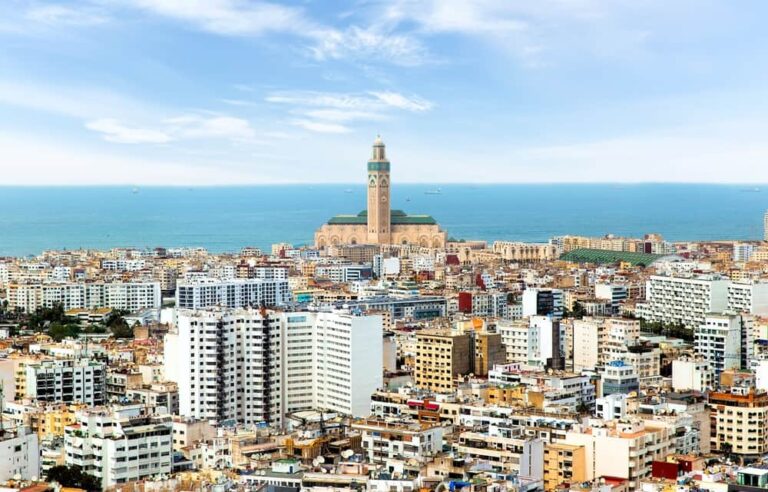Draa Valley

The Draa Valley is one of Morocco’s hidden treasures, stretching through the southern part of the country. It is known for its natural beauty, rich history, and the lush palm groves that run along the Draa River. The valley begins in the High Atlas Mountains and flows toward the Sahara Desert, creating a striking landscape of green oases surrounded by desert.
The Draa Valley has been a vital part of Moroccan life for centuries. It was once an important trade route, linking Morocco with the rest of Africa. Traders carried goods like gold, salt, and dates through this region, making the valley a busy and prosperous area. Today, visitors can explore its ancient kasbahs, fortified villages, and discover its cultural heritage.
Whether you’re interested in the historic sites or the stunning views of the Sahara, the Draa Valley offers a unique travel experience. The area is also perfect for camel trekking, hiking, or simply enjoying the quiet charm of traditional Berber villages.
Understanding the Geography of the Draa Valley
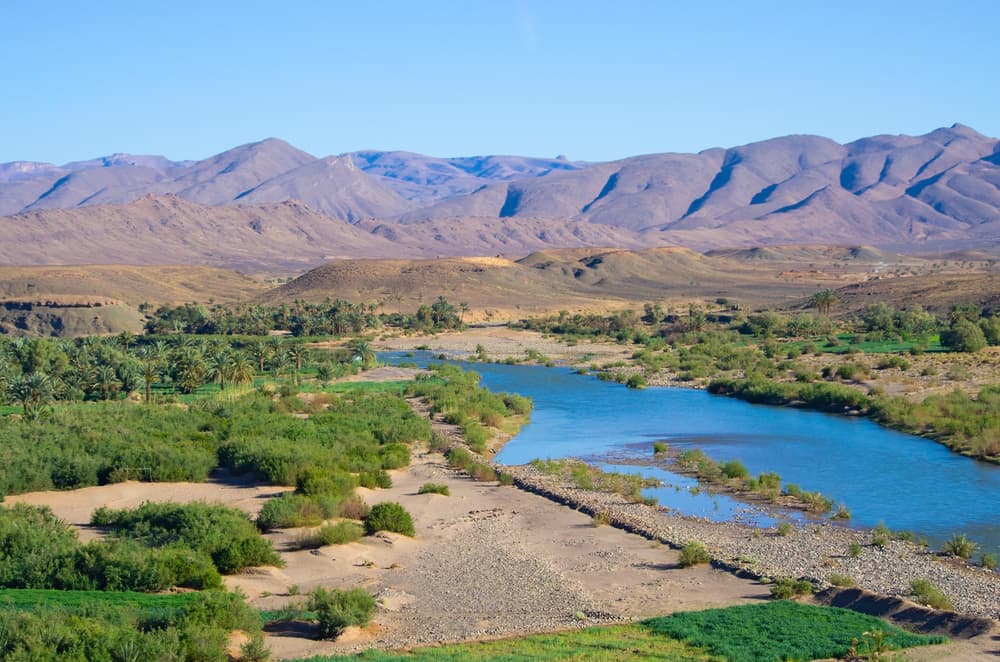
The Draa Valley is located in southern Morocco. It begins in the High Atlas Mountains and winds its way down to the Sahara Desert. The Draa River, which is the longest river in Morocco, flows through this valley. Over time, the river has created lush oases, making the region a green lifeline amid the dry, rocky desert landscape.
The valley is famous for its palm groves. These groves provide shade and are home to thousands of date palms. Farmers use the fertile land around the river to grow crops, making the valley an important agricultural area in a mostly arid region.
Surrounding the valley, you will find a mix of mountains, deserts, and small Berber villages. The changing landscape makes the Draa Valley a scenic and interesting place to visit, with panoramic views of the Sahara and the Atlas Mountains visible from many points. Travelers come here to enjoy both the natural beauty and the peaceful atmosphere.
How to Get to the Draa Valley: A Traveler’s Guide
Reaching the Draa Valley is easy from many parts of Morocco. The closest major city is Ouarzazate, known as the gateway to the desert. From Ouarzazate, it takes about two hours by car to reach the valley. You can also travel from Marrakech, which is a longer drive through the scenic Tizi n’Tichka Pass in the Atlas Mountains.
For those who prefer public transportation, there are buses that travel to the valley from Marrakech and Zagora. The roads are generally well-maintained, making the journey smooth. Another option is to join a guided tour. Many tours include stops at key points along the way, such as the Ait Benhaddou Kasbah or the Skoura oasis.
If you want to take your time, renting a car allows you to explore the valley at your own pace. This way, you can stop to enjoy the views, visit small villages, and even arrange for a camel trek into the desert.
Best Places to Visit in the Draa Valley

The Draa Valley is one of Morocco’s most captivating regions, offering visitors a rich blend of history, culture, and natural beauty. It is home to ancient kasbahs, traditional Berber villages, and stunning landscapes that shift from lush oases to desert dunes. Below are the must-see places in the Draa Valley that provide a glimpse into the heart of this fascinating area.
1. Kasbah Tamnougalt
Located just outside the town of Agdz, Kasbah Tamnougalt is one of the most important historical landmarks in the Draa Valley. This ancient fortress dates back to the 16th century and was once the political and administrative center of the region. Built using traditional Berber methods, the kasbah’s walls are made of mud-brick, providing a glimpse into the architectural styles of the time. Tamnougalt was also a vital stop along the trans-Saharan trade routes, protecting caravans carrying goods like gold, salt, and dates.
Visitors can explore the kasbah’s many rooms, passageways, and towers. You can enjoy sweeping views of the Draa River and the surrounding palm groves from its roof. The site has been partially restored, but it still retains much of its original charm and offers a direct connection to the valley’s past. Tamnougalt is also a popular filming location for movies due to its authentic and atmospheric setting.
2. Zagora
As the largest town in the Draa Valley, Zagora serves as the main hub for travelers and adventurers heading into the Sahara Desert. The town is often called the “Gateway to the Sahara” because it is one of the last major settlements before reaching the desert. Historically, Zagora was a key stop on the trade routes connecting Morocco with West Africa and today it remains a lively and vibrant town.
Zagora’s bustling souk (market) is a great place to experience traditional Moroccan culture. Here, you’ll find vendors selling everything from Berber rugs and pottery to spices and jewelry. The town is also known for its iconic sign that reads “Timbuktu 52 days by camel”, a reminder of the days when caravans set out from here on long journeys across the desert.
Zagora is also the starting point for many desert excursions, including camel treks and 4×4 tours to the Erg Chegaga dunes. Whether you’re interested in exploring the Sahara or simply enjoying the atmosphere of a traditional Moroccan town, Zagora is a must-visit.
3. Amezrou Village
Located just outside of Zagora, Amezrou is a small but historically significant village. It is known for its skilled silversmiths who have been crafting intricate jewelry for generations. The village is home to workshops where visitors can watch artisans at work, creating beautiful silver pieces that reflect Berber cultural heritage.
In addition to its jewelry-making tradition, Amezrou has a small but important Jewish quarter, which dates back to a time when the Jewish population was integral to the region’s craft and trade. Exploring this part of the village provides insight into the diverse cultures that have coexisted in the Draa Valley over the centuries.
Amezrou is a peaceful and welcoming place, offering a quieter alternative to the busier towns in the valley. It’s the perfect spot to experience traditional Berber life while learning about the valley’s artistic heritage.
4. Tamegroute
Located about 20 kilometers south of Zagora, Tamegroute is one of the Draa Valley’s most culturally and historically important villages. Its most famous attraction is the Tamegroute Library, which houses one of the oldest collections of manuscripts in North Africa. This library contains rare and ancient books, including texts on science, religion, astronomy, and mathematics, some of which date back to the 12th century. It offers a fascinating look at Morocco’s scholarly past and its role in the Islamic world’s intellectual history.
Tamegroute is also renowned for its distinctive green pottery, which is made using traditional methods passed down through generations. Visitors can tour local pottery workshops and even participate in the process of crafting these beautiful ceramics, which are used throughout the region and make for excellent souvenirs.
In addition to the library and pottery, Tamegroute is known for its religious significance as a center for Sufi learning. The village is home to a large zawiya (Islamic school) and a revered tomb of a local saint, attracting pilgrims from across the country.
5. Agdz
Situated at the northern end of the Draa Valley, Agdz is a small town that serves as the gateway to the valley’s palm groves and ancient kasbahs. Its name means “resting place” in Berber, and it lives up to this name with its tranquil atmosphere. The town is surrounded by palm groves and overlooked by the dramatic peaks of the Jebel Kissane mountain.
One of Agdz’s key attractions is the Kasbah des Caids, a large, well-preserved fortress that once belonged to the ruling family of the area. This kasbah, like many others in the Draa Valley, was built to protect the town and its residents from invasions. Today, it is open to visitors who can explore its maze-like corridors and climb its towers for stunning views of the valley below.
Agdz is also an excellent base for exploring the nearby Draa River and its oases. Visitors can take walks through the palm groves, visit small farms, and see traditional irrigation systems that have sustained life in the valley for centuries.
6. The Draa River and Oasis of Life
The Draa River is the backbone of the valley, running over 1,100 kilometers and creating a series of lush oases in an otherwise arid landscape. These oases are vital to life in the Draa Valley, providing water for agriculture and supporting the region’s dense date palm groves. The oases are not only beautiful to look at but also play a crucial role in the valley’s economy, with dates being one of the most important crops.
Travelers can explore the Oasis of Life, which stretches for miles along the river. Walking or biking through the palm groves offers a chance to see traditional agriculture in action, with farmers using ancient irrigation techniques to water their crops. The oasis is also home to a variety of wildlife, including birds that thrive in this green corridor amid the desert.
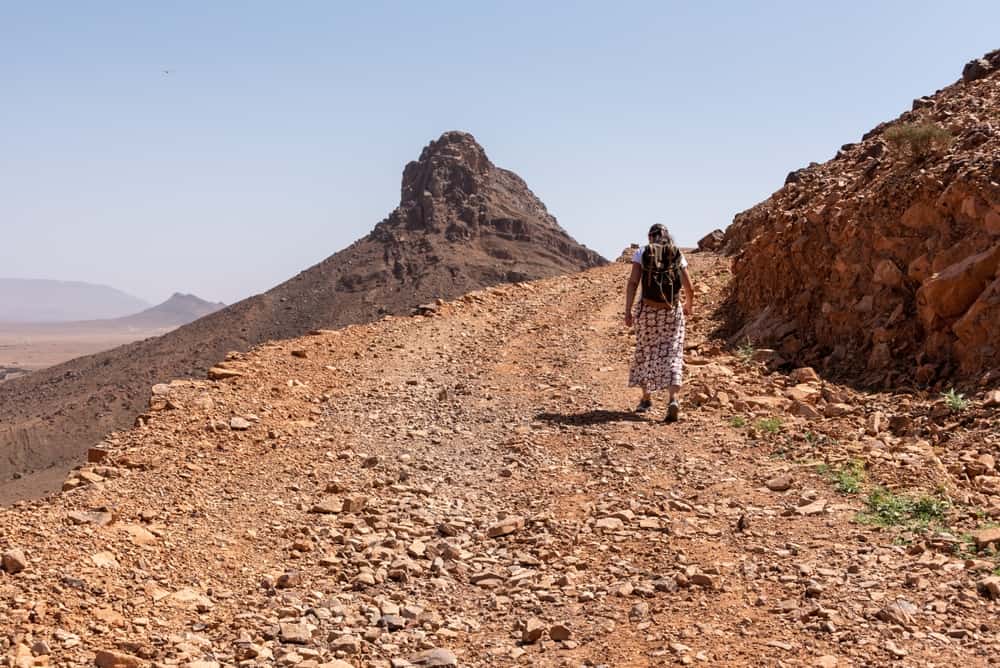
7. Jebel Zagora
For travelers who love hiking, Jebel Zagora is one of the top attractions in the Draa Valley. This mountain is located near the town of Zagora and offers a relatively easy trek to its summit. From the top, visitors are treated to breathtaking panoramic views of the Draa Valley, with the palm groves and villages stretching out below, and the Sahara Desert visible in the distance.
Hiking Jebel Zagora is particularly rewarding at sunrise or sunset when the light creates stunning contrasts across the landscape. The trek itself is suitable for most fitness levels and can be completed in just a few hours, making it a popular activity for visitors to the valley.
8. M’Hamid El Ghizlane
At the far southern end of the Draa Valley lies M’Hamid El Ghizlane, the last oasis before the vast expanse of the Sahara Desert. This small, quiet town is the starting point for many desert adventures, including multi-day treks into the desert and excursions to the nearby Erg Chegaga dunes, some of the highest in Morocco.
Unlike the more touristy Merzouga region, M’Hamid offers a more authentic desert experience. Visitors can ride camels into the desert, spend the night in a nomadic camp, and enjoy the peace and tranquility of the Sahara. The town itself has a timeless quality, with mud-brick houses, narrow streets, and a slower pace of life that allows visitors to fully immerse themselves in the desert environment.
9. Ait Isfoul
Ait Isfoul is a small but historically significant village located within the Draa Valley. Like many other villages in the region, it is home to a kasbah that has stood for centuries, protecting its residents from attacks. The village’s narrow alleyways and mud-brick houses are typical of traditional Berber architecture, offering visitors a chance to step back in time.
Exploring Ait Isfoul is like walking through a living museum, where the traditions of the past are still very much alive today. Visitors can meet local families, learn about traditional farming methods, and experience the hospitality that the people of the Draa Valley are known for.
10. Erg Chegaga Dunes
While not technically within the Draa Valley, the Erg Chegaga dunes are a natural extension of any trip to the region. These massive dunes, located near M’Hamid, are among the tallest in Morocco, reaching heights of up to 300 meters. The Erg Chegaga offers a range of desert activities, including camel treks, sandboarding, and 4×4 tours.
For many visitors, the highlight of their trip is camping overnight in the Sahara Desert. Sleeping under the stars, surrounded by towering dunes, is an unforgettable experience. The desert’s silence, broken only by the occasional gust of wind, creates a sense of peace and isolation that is hard to find anywhere else.
The Historical Significance of the Draa Valley
The Draa Valley has a long and rich history. For centuries, it was a key part of the trans-Saharan trade routes. Traders carried valuable goods like salt, gold, and spices through this valley, connecting Morocco to the rest of Africa and even beyond. This made the valley a very busy and important place in ancient times.
Many of the fortified villages and kasbahs that you see today were built during this period. They served as protection from invaders and provided safe havens for traders and their caravans. One of the most famous historical sites in the valley is the Kasbah Tamnougalt, which has stood for centuries and remains a symbol of the valley’s past.
Today, visitors can still feel the echoes of history as they walk through the ancient streets of these villages. The history of the Draa Valley is not only about trade but also about the people who have lived there, including the Berber tribes who have called this valley home for generations.
Rich Cultural Heritage of the Draa Valley
The Draa Valley is known for its deep Berber roots. The Berbers are one of the oldest groups of people in North Africa, and their influence can be seen everywhere in the valley. The people living here still follow many traditional Berber customs and speak the Tashelhit dialect, a branch of the Berber language.
One of the most striking aspects of Berber culture is their craftsmanship. In the Draa Valley, you can find beautiful pottery, intricate jewelry, and handwoven rugs. These items are often sold in local markets, or souks, where travelers can purchase them as souvenirs.
Religion also plays a key role in the valley’s culture. The spread of Islam brought changes in the valley’s art, architecture, and way of life. This is seen in the mosques and Kasbahs, which feature Islamic influences in their designs.
Festivals are another way to experience the cultural heritage of the valley. These events often include traditional music, dancing, and food. The Date Festival is particularly popular, celebrating the valley’s abundant date harvest.
Must-See Attractions in the Draa Valley
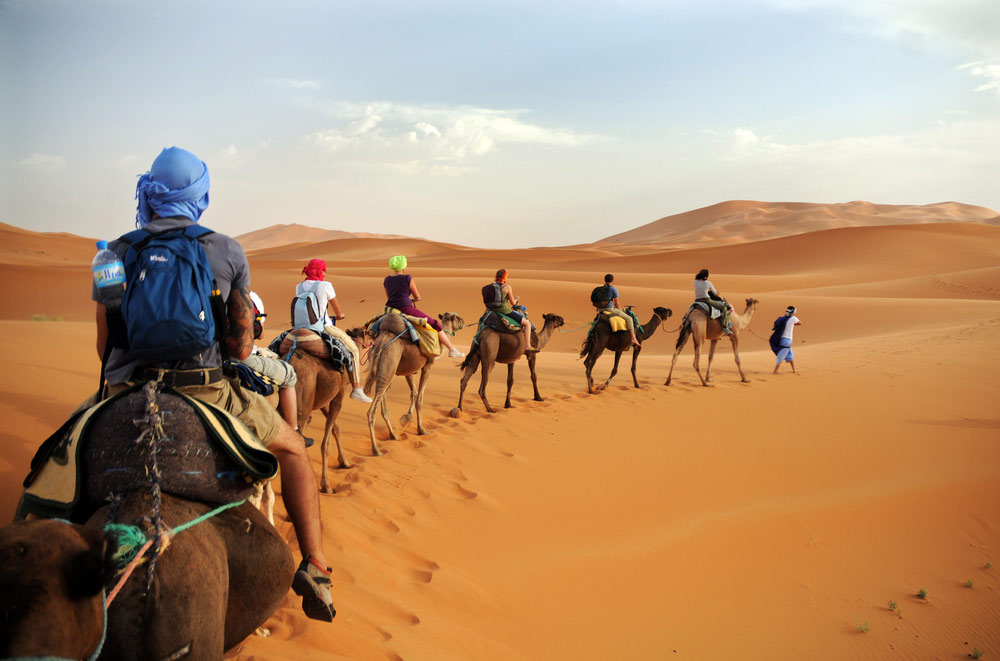
The Draa Valley is full of sights that are not to be missed. One of the top attractions is the Oasis of Life, a green paradise surrounded by desert where travelers can rest and admire the natural beauty of the area. The oasis is a major stop for those visiting the valley and provides breathtaking views of the palm groves.
Another must-see is the Kasbah Tamnougalt, one of the valley’s oldest and most famous fortresses. Walking through its ancient walls gives visitors a sense of what life was like centuries ago.
For those interested in history, the village of Tamegroute is home to a historic library that contains old manuscripts and religious texts. It also has a pottery workshop where locals continue to make traditional green pottery.
The Sahara Desert is also nearby, and no visit to the Draa Valley is complete without experiencing the desert landscape, whether through a camel trek or a night in a traditional nomadic camp.
Activities for Travelers in the Draa Valley
The Draa Valley offers a wide range of activities for visitors. One of the most popular is camel trekking, where you can ride a camel through the desert and experience what it was like for traders and nomads of the past. These treks often include overnight stays in the Sahara, where you can camp under the stars.
Hiking is another favorite activity. The valley has many trails that take you through the palm groves, small Berber villages, and up into the Atlas Mountains. The walks offer incredible views of the surrounding landscapes and are a great way to experience the valley’s natural beauty.
For those who prefer a more relaxed pace, visiting the local markets in Zagora or Agdz can be a rewarding experience. Here, you can buy traditional crafts, spices, and fresh produce while soaking in the vibrant atmosphere.
The Ancient Villages and Kasbahs of the Draa Valley
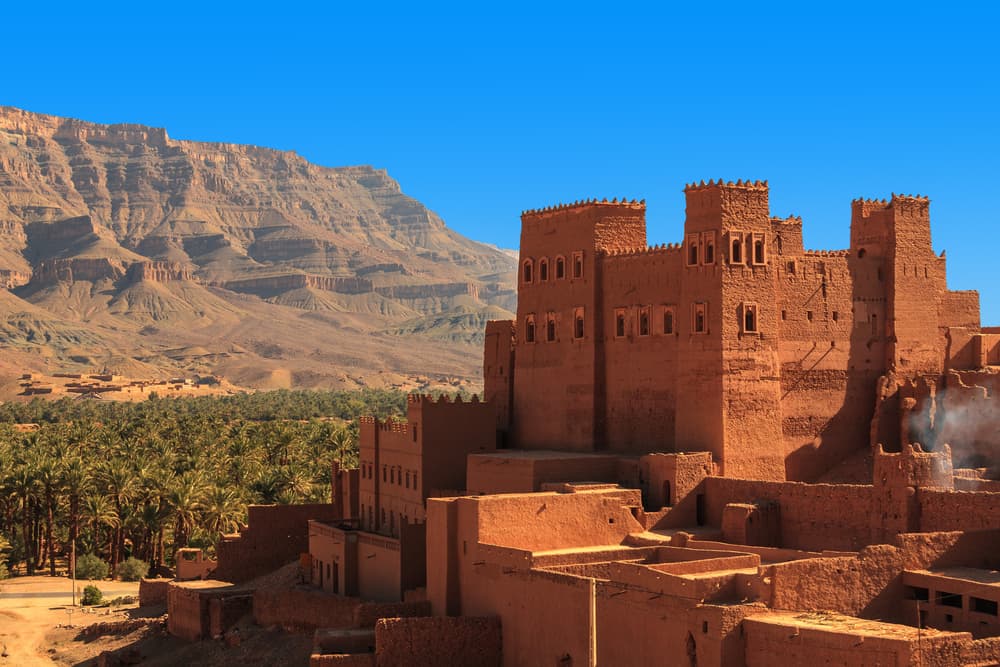
The Draa Valley is dotted with ancient kasbahs and villages, many of which have stood for hundreds of years. These fortified structures were built to protect the people and their homes from invaders. Today, they offer a glimpse into the valley’s rich past.
One of the most famous villages is Amezrou, where visitors can see how traditional silver jewelry is made. Another important stop is Agdz, a small village known for its charming architecture and peaceful atmosphere.
The kasbahs, like Kasbah Tamnougalt and Kasbah des Caids, are stunning examples of the valley’s historical architecture. Their high walls and intricate designs make them a must-see for anyone interested in history or architecture.
Trekking and Outdoor Adventures in the Draa Valley
The Draa Valley is a paradise for outdoor enthusiasts. There are several trekking routes that take you through the valley’s varied landscapes, from the Atlas Mountains to the edge of the Sahara. One of the most popular hikes is the Jebel Zagora trek, which offers stunning views of the surrounding desert.
For those who want a more relaxed adventure, bike tours are available. These tours take you through the palm groves and past the kasbahs, offering a unique perspective of the valley.
For desert lovers, there’s nothing like a 4×4 tour or a camel trek into the Sahara. Many travelers choose to camp overnight, giving them a chance to experience the desert under the starry night sky.
Conclusion
The Draa Valley stands out as one of Morocco’s most unique destinations, offering a blend of natural beauty, historical richness, and cultural heritage. From the towering Atlas Mountains to the sprawling Sahara Desert, the valley’s landscape is diverse and breathtaking. Its lush palm groves, flowing Draa River, and ancient kasbahs make it a place where history and nature meet in perfect harmony.
Traveling through the valley, you’ll encounter not just beautiful scenery, but also a deep sense of history. The Draa Valley’s role as a key trade route has left its mark in the form of fortified villages, traditional Berber customs, and remarkable architectural treasures. Visitors can explore these relics of the past while enjoying the peaceful, slow pace of life in the valley’s Berber villages.
Whether you’re trekking in the Atlas Mountains, riding camels through the Sahara, or visiting the ancient kasbahs, the Draa Valley promises an unforgettable experience. It’s a place where you can immerse yourself in both adventure and tranquility, making it a must-visit for anyone looking to discover the heart of Morocco.
FAQs
Is the Draa Valley safe for tourists?
Yes, it’s generally safe, with friendly locals and regular tourists, but always follow basic safety guidelines.
What is the best time of year to visit the Draa Valley?
Spring (March-May) and autumn (September-November) are the best times due to mild weather.
Are there guided tours available in the Draa Valley?
Yes, various guided tours are available, including day trips and multi-day excursions.
What kind of accommodation is available in the Draa Valley?
Options include Berber guesthouses, kasbah lodges, luxury desert camps, and basic hotels.
Can I visit the Draa Valley on a day trip from Marrakech?
It’s possible but not recommended. The journey is long, so spending at least two days is better.
What should I pack for a trip to the Draa Valley?
Pack light, breathable clothes, warm layers for night, good shoes, sunscreen, and water.
Is it possible to visit the Draa Valley as part of a Sahara Desert tour?
Yes, many Sahara Desert tours include stops in the Draa Valley, often on the way to the desert dunes.
